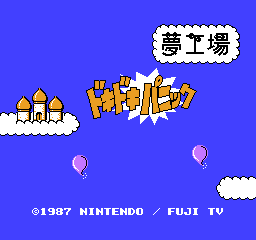Doki Doki Panic (Heart-Pounding Panic) is a side-scrolling platformer developed by Nintendo in collaboration with Japanese TV network Fuji TV in order to help promote their 1987 Yume Koujou (Dream Factory) event. The game revolves around an Arabian family who must venture into a dream world inside a storybook in order to rescue their two youngest children from the evil ruler Wart.
It is better known in the west as the game that served as the basis for the international version of Super Mario Bros. 2, with many of its original elements and characters ending up being incorporated into the Mario canon through their inclusion in subsequent games.
| To do:
There could be some unused graphics other than the smiley face. |
Unused Graphics

Inside the tileset for the desert stages is a little smiley face that isn't used anywhere in this game or the prototype and final versions of Super Mario Bros. 2. It appears to just be a placeholder.
Anti-Piracy
Using early disk copying utilities would create imperfect copies of the disk due to the header field, which says how many files are on the disk, being set to one less than what there actually is. This means that the file DUMMY-DT does not get copied to the new disk. This file changes code which would normally produce this screen when the disk is set to Side B. To see this screen, remove DUMMY-DT from Side B or set the PC to $66A2 before entering a level.
|
|
|---|
| NES/FDS | Super Mario Bros. (All Night Nippon) • Super Mario Bros. 2 (FDS) • Super Mario Bros. 2 (NES) (Prototype, Doki Doki Panic) • Super Mario Bros. 3 |
|---|
| Game Boy (Color) | Super Mario Land • Super Mario Land 2: 6 Golden Coins • Wario Land: Super Mario Land 3 • Super Mario Bros. Deluxe |
|---|
| SNES | Super Mario World (Localization Prototype) • Super Mario All-Stars • Super Mario World 2: Yoshi's Island (Prototypes) |
|---|
| Satellaview | BS Super Mario USA • BS Super Mario Collection |
|---|
| Nintendo 64(DD) | Super Mario 64 (iQue Prototypes, 64DD Version) |
|---|
| Game Boy Advance | Super Mario Advance • Super Mario Advance 2 • Super Mario Advance 3 • Super Mario Advance 4 |
|---|
| GameCube | Super Mario Sunshine (Demo) |
|---|
| Nintendo DS | Super Mario 64 DS • New Super Mario Bros. |
|---|
| Wii | Super Mario Galaxy • New Super Mario Bros. Wii • Super Mario Galaxy 2 • Super Mario All-Stars |
|---|
| Nintendo 3DS | Super Mario 3D Land (Demo) • New Super Mario Bros. 2 |
|---|
| Wii U | New Super Mario Bros. U (New Super Luigi U) • Super Mario 3D World |
|---|
| iOS, Android | Super Mario Run |
|---|
| Nintendo Switch | Super Mario Odyssey • New Super Mario Bros. U Deluxe • Super Mario 3D All-Stars • Super Mario Bros. 35 • Super Mario 3D World + Bowser's Fury • Super Mario Bros. Wonder (Kiosk Demo) |
|---|
| Game & Watch | Game & Watch: Super Mario Bros. |
|---|
|
| Mario Kart |
|---|
| Console Games | Super Mario Kart (Prototypes) • Mario Kart 64 (iQue Prototype) • Mario Kart: Double Dash!! (Demos, Bonus Disc) • Mario Kart Wii (Mario Kart Channel) • Mario Kart 8 • Mario Kart 8 Deluxe (Prototype) |
|---|
| Handheld Games | Mario Kart: Super Circuit • Mario Kart DS (Demos) • Mario Kart 7 • Mario Kart Tour (Closed Beta) |
|---|
| Arcade Games | Mario Kart Arcade GP • Mario Kart Arcade GP 2 • Mario Kart Arcade GP DX |
|---|
|
| RPGs |
|---|
| Super Mario RPG | Legend of the Seven Stars (Switch) |
|---|
| Paper Mario | Paper Mario • The Thousand-Year Door (Demos, Switch) • Super Paper Mario • Sticker Star • Color Splash • The Origami King |
|---|
| Mario & Luigi | Superstar Saga (Prototype, + Bowser's Minions) • Partners in Time • Bowser's Inside Story (+ Bowser Jr.'s Journey) • Dream Team • Paper Jam • Brothership |
|---|
| Mario + Rabbids | Kingdom Battle • Sparks of Hope |
|---|
|
| Mario Party |
|---|
| Console Games | Mario Party • Mario Party 2 • Mario Party 3 (Prototype) • Mario Party 4 (Demo) • Mario Party 5 (Demo) • Mario Party 6 (Demo) • Mario Party 7 • Mario Party 8
Mario Party 9 • Mario Party 10 • Super Mario Party • Mario Party Superstars |
|---|
| Handheld Games | Mario Party Advance • Mario Party DS • Mario Party: Island Tour |
|---|
| Web Games | Mario Party 7: Bowser's Lair Hockey |
|---|
|
| Sports |
|---|
| Golf | NES Open Tournament Golf • Mario Golf (N64, GBC) • Mario Golf: Toadstool Tour • Mario Golf: Advance Tour • Mobile Golf |
|---|
| Tennis | Mario's Tennis • Mario Tennis (N64, GBC) • Mario Power Tennis • Mario Tennis: Power Tour (Bicep Pump) • Mario Tennis Aces |
|---|
| Strikers | Super Mario Strikers (Demo) • Mario Strikers Charged • Mario Strikers: Battle League |
|---|
| Baseball | Mario Superstar Baseball (Mario Baseball Demo) • Mario Super Sluggers |
|---|
| Mario & Sonic at the Olympic Games | Beijing 2008 (DS, Wii) • Vancouver 2010 (DS, Wii) • London 2012 • Rio 2016 (Wii U, Arcade) |
|---|
| Other | Excitebike: Bun Bun Mario Battle • Mario Pinball Land • Dance Dance Revolution Mario Mix • Mario Sports Mix |
|---|
|
| Dr. Mario |
|---|
| Console Games | Dr. Mario (Prototypes) • Tetris & Dr. Mario • Dr. Mario 64 • Nintendo Puzzle Collection • Dr. Luigi |
|---|
| Handheld Games | Dr. Mario • Dr. Mario & Puzzle League • Dr. Mario Express • Dr. Mario World |
|---|
| Web Games | Dr. Mario: Vitamin Toss |
|---|
|
| Super Mario Maker |
|---|
| Wii U | Super Mario Maker |
|---|
| Nintendo 3DS | Super Mario Maker for Nintendo 3DS |
|---|
| Nintendo Switch | Super Mario Maker 2 |
|---|
|
| Mario vs. Donkey Kong |
|---|
| Handheld Games | Mario vs. Donkey Kong (Demo) • March of the Minis (Demo) • Minis March Again! • Mini Land Mayhem! • Tipping Stars • Mini Mario & Friends: amiibo Challenge |
|---|
| Console Games | Tipping Stars • Mini Mario & Friends: amiibo Challenge |
|---|
|
| Mario Bros. |
|---|
| Arcade | Mario Bros. |
|---|
| NES/FDS | Mario Bros. (Kaettekita) |
|---|
| PC-88 | Punch Ball Mario Bros. |
|---|
| Virtual Boy | Mario Clash |
|---|
| Game Boy Advance | Mario Bros. Classic |
|---|
|
| Mario's Picross |
|---|
| Game Boy | Mario's Picross • Picross 2 |
|---|
| SNES | Mario's Super Picross |
|---|
|
| Captain Toad |
|---|
| Wii U | Treasure Tracker |
|---|
| Nintendo Switch, Nintendo 3DS | Treasure Tracker |
|---|
|
| Donkey Kong |
|---|
| Arcade | Donkey Kong • Donkey Kong Jr. |
|---|
| Atari 8-bit family | Donkey Kong (Prototype) |
|---|
| NES/FDS | Donkey Kong • Donkey Kong Jr. |
|---|
| Game Boy | Donkey Kong |
|---|
|
| Luigi's Mansion |
|---|
| GameCube | Luigi's Mansion |
|---|
| Nintendo 3DS | Dark Moon • Luigi's Mansion |
|---|
| Arcade | Luigi's Mansion Arcade |
|---|
| Nintendo Switch | Luigi's Mansion 3 • Luigi's Mansion 2 HD |
|---|
|
| Princess Peach |
|---|
| Nintendo DS | Super Princess Peach |
|---|
| Nintendo Switch | Princess Peach: Showtime! |
|---|
| Adobe Flash | Super Princess Peach: Parasol Fall |
|---|
|
| Wrecking Crew |
|---|
| NES/FDS | Wrecking Crew |
|---|
| SNES | Wrecking Crew '98 |
|---|
|
| Art |
|---|
| Console Games | Mario Paint (Prototype) • Mario Artist Paint Studio (Prototype) • Mario Artist Talent Studio • Mario Artist Communication Kit • Mario Artist Polygon Studio
I am a Teacher: Super Mario no Sweater • Mario no Photopi |
|---|
| Handheld Games | Jaguar Mishin Sashi Senyou Soft: Mario Family • Photos with Mario |
|---|
|
| Educational |
|---|
| Computer Games | Mario is Missing! • Mario's Early Years • Mario Teaches Typing |
|---|
| Console Games | Mario is Missing! (SNES, NES) • Mario's Time Machine (SNES, NES) • Mario's Early Years |
|---|
|
| Miscellaneous |
|---|
| Arcade Games | Mario Roulette |
|---|
| Computer Games | Mario's Game Gallery |
|---|
| Console Games | Mario & Wario • Yoshi's Safari • Undake 30: Same Game Mario Version • Hotel Mario (Prototype) • Super Mario's Wacky Worlds • Fortune Street |
|---|
| Handheld Games | Mario Clock • Puzzle & Dragons: Super Mario Bros. Edition |
|---|
| Compilations | Donkey Kong, Donkey Kong Jr., Mario Bros. • 3-in-1 Super Mario Bros. / Duck Hunt / World Class Track Meet |
|---|
| Competitions | Nintendo World Championships 1990 • Nintendo Campus Challenge 1991 • Nintendo Campus Challenge 1992 • Nintendo PowerFest '94 |
|---|
|
| See Also |
|---|
| Donkey Kong • Game & Watch • Wario • Yoshi |

